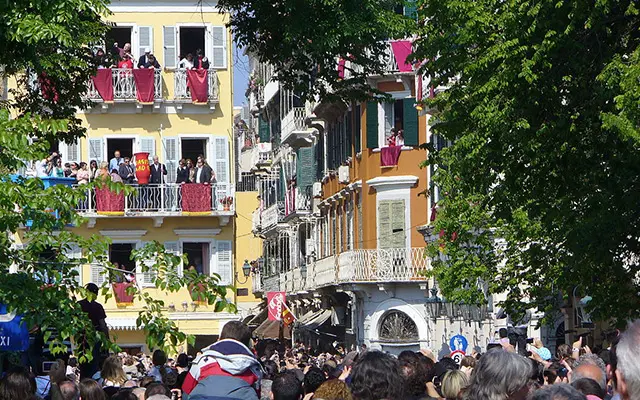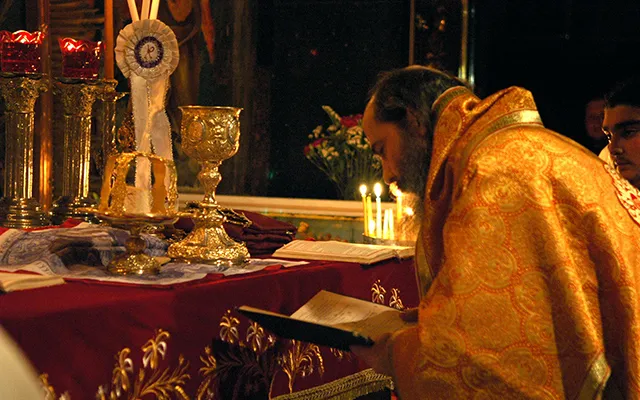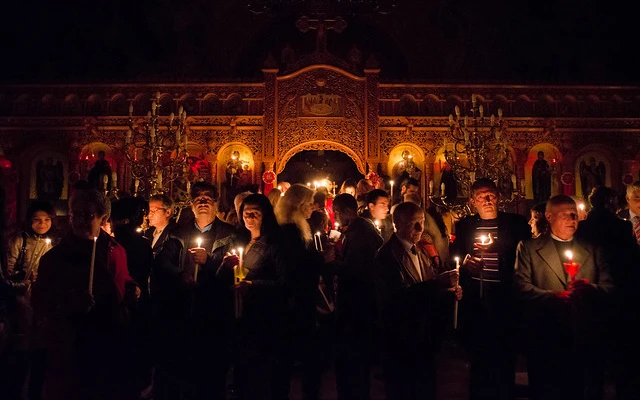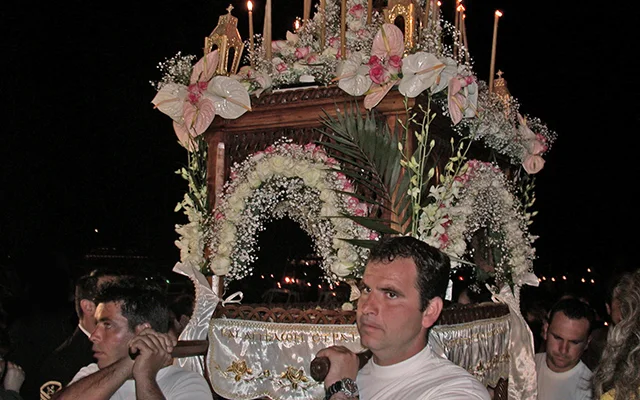Traditions & customs of the Greek Orthodox Easter
Discover the orthodox practices and experience the unique spiritual atmosphere that dominates the Easter celebration in Greece.
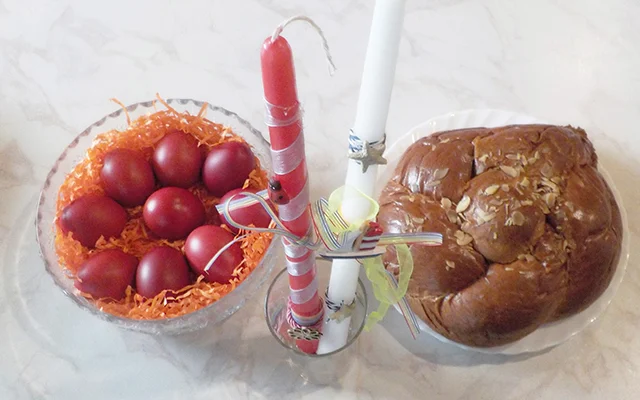
As the longest and most celebrated religious festivity for Greeks, the Orthodox Easter (Pascha) includes a vast variety of customs, rituals, and traditions that are followed during the celebration period. During this period every single visitor who happens to be a guest of a Greek city or village has the opportunity to feel the cultural and spiritual atmosphere of the celebration.
The series of followed practices and customs are significant parts of the Greek population cultural identity. Regardless of the level of personal religious faith, Greek communities are keen on following the majority of them and celebrate Pascha with commitment and devotion.
Easter fasting (Nysteia)
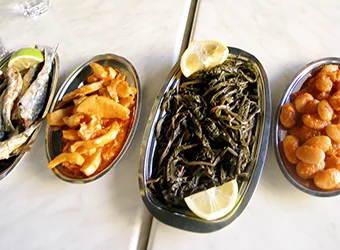
The fasting period before the Greek Easter starts on the Clean (Ash) Monday and expands for 40 days. Given that the Greek Orthodox Church adopts the Byzantine monastic rules, the fasting is quite strict and demanding.
The Great Lent aims to the cleansing of mind and body on the preparation of receiving God’s message and commands the abstaining from each body and mind pleasure. Food is one of them, so the faithful are called to abstain from meat, animal products, dairy, fish, eggs and sometimes even olive oil.
On some special days like Palm Sunday, eating fish is allowed, while on Wednesdays and Fridays believers sustain only on bread, fruits, and vegetables. On Great Friday, some eat only bread and vinegar commemorating the vinegar wine that was offered to Jesus on the cross.
Housecleaning
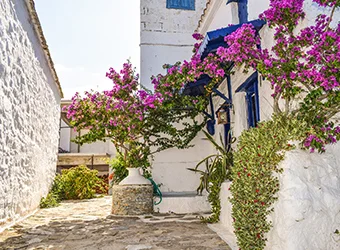
It is a tradition for the majority of the Greek households to go through cleaning and minor restoration processes during some days of the Great (Holy) Week and before the weekend of the Easter feast.
This custom refers to interesting religious parallelisms. More specifically, as each faithful prepares his/her inner self with prayer and fasting to receive the Holy Communion and the Easter message, in the same way, the house of each family should be clean and purified for the major religious occasion.
Additionally, during the Easter period, people are used to visiting their families and the “extended Greek family” gathers in villages and second homes. Consequently, the days before Easter are considered as good timing to refurbishment before the festive common celebration.
Greek sweet bread (Tsoureki)
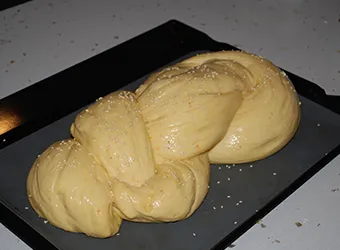
There is one special pasty with a characteristic smell and taste that is highly associated with the Greek Easter (Pascha). This is the tsoureki (Greek: τσουρέκι).
It is a sweet bread made with milk, butter, and eggs prepared on Great Thursday at numerous Greek households. Its' alluring baking smell spreads in the environment and even if it cannot be consumed before the Sunday morning (due to the fasting principals) it signifies the approaching of the great feast.
It is argued that the tradition has its' roots in the pagan world where bread was symbolizing life and the braid pattern (that it takes before it is baked) was a motif capable to chase the evil spirits away. Its' name probably adopted by Greeks during the Ottoman occupation and today similar bread recipes can be found in Turkey, Armenia and Azerbaijan under the name “corek” or “churek”.
Red eggs
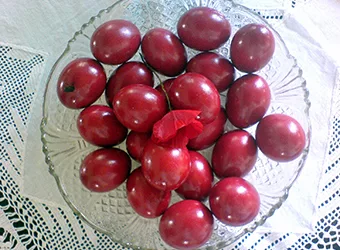
Historically, the egg is the symbol of new life and rebirth. At the Greek Easter, the eggs are dyed in red color, commemorating Christ’s blood that was shed at his crucifixion.
The dyeing process is taking place on Great Thursday. Many use dyes while the recent years more and more chose the traditional way that recommends onion peels and common madder roots as dyeing materials.
The red eggs are to be eaten after the Midnight Resurrection Liturgy but before the consumption, a special competition should be preceded. This is the egg-cracking custom where relatives and friends are cracking the red eggs with each other. The one with the strongest egg is the winner, while the cracked eggs symbolize the gates of the kingdom of the dead that were smashed with Christ's resurrection.
Candles (Lambada)
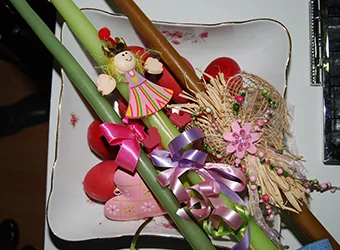
One very significant custom that is followed during the Easter period, is related to the candle (Greek: Λαμπάδα -lambada-) and the other gifts which are offered from the godfather (or the godmother) to the child who was baptized by him (or her).
Traditionally, the Greek Orthodox Church finds baptism as one of the most important events in people's lives. Orthodox believers are getting baptized at an early age (between 1-2 years old) and their godfathers/godmothers (spiritual parents) are considered as people with significance almost equal to their biological parents. Consequently, on such a significant feast like Easter, the godfather (or the godmother) has a prominent role in the typical extended-family celebration.
Thus, it is a habit for every child to receive the Easter candle and probably some other gifts (or money) from his or her godfather/godmother. Given that this tradition is followed mainly for children the candles are colorful with funny patterns and in many cases they have some toys attached to them. Those candles are received prior to the celebration or during the Holy Week and the children bring them to the church during the Great Saturday in order to get the Holy Flame.
Epitaph procession / decorations (Epitaphios)
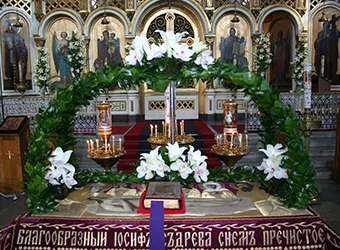
One of the major highlights for the Easter celebration is the Epitaph procession. The clergy and the parishioners carry and transfer the Epitaph around the church and the streets of their parish as a representation of Jesus’ funeral service.
The Epitaph typically bears wonderful flower decorations and the decoration process is a standard tradition on its own. On Great Thursday, parishioners (especially women and girls) reach the churches of cities and villages bringing flowers and greenery that are the main decorating ornaments of the Epitaph.
They attach them to the wooden structure making colorful patterns that transform the Epitaph to a piece of art. Different flowers of the local flora like lilacs, hyacinths, anemones, daisies, field flowers, lilies, roses, lemon flowers, and violets are potential ornaments, while each color has a specific symbolization. For example, purple symbolizes mourning, red implicates blood and white stands for purity.
Holy Fire (Agio Fos)
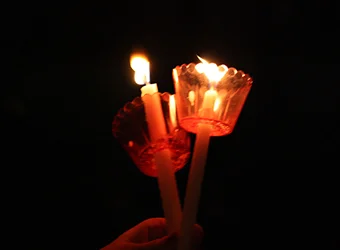
The Holy Fire (Greek: Άγιο Φώς -Holy Light-) is the fire flame that symbolizes Christ’s Resurrection and is distributed by the priest at Saturday midnight on the Easter Vigil. The emergence of the Holy Fire is considered as a miracle on its own for the Greek Orthodox Church.
According to the tradition, it is received miraculously by the Greek Orthodox Patriarch in the Chapel of Christ’s tomb in the Church of the Holy Sepulchre in Jerusalem. The Patriarch enters the chapel 12 hours before Saturday’s midnight only after the Jewish soldiers and bishops from other Christian churches reassure that there is no other source of fire in the chapel. He stays inside alone and after a few minutes he comes out holding to bunches of lit candles (33 candles each - equal to the age of Jesus) in his hands. Then, the Holy Fire is distributed to the faithful and travels to every corner of the globe where an Orthodox Church exists.
The Holy Fire reaches Athens on a special flight arranged by the state and it is honored as a state leader. From Athens, parishioners receive the Holy Flame to bring it to different churches across the country.
The Easter greeting (Christos Anesti)
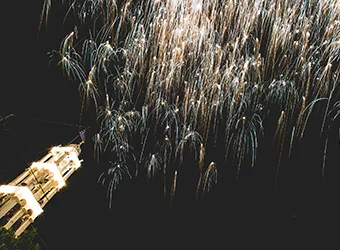
After the priest calls out “Christos Anesti” (Christ has risen) at the Midnight resurrection liturgy, the main greeting within Greek communities converts to a religious one! People greet each other with “Christos Anesti” while the answer is “Alithos Anesti” (indeed He has risen).
Family members, friends, relatives, and neighbors exchange it as a wish, while it replaces common greetings like hello, good morning and so on. Some decades ago, this was used to be the main greeting in the communities for 40 days after Easter Sunday and even today many try to keep this custom. This tradition symbolizes a confession of faith between Orthodox believers.
Easter Soup (Mayiritsa)
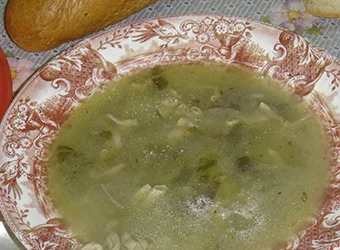
Christ’s resurrection brings the end of the 40-day fasting period and the dish that introduces the faithful to the festive meat-eating occasion and the rich Easter foods is mayiritsa.
This is a special soup cooked typically on Easter and served just after the Easter vigil around 02:00 on Easter Sunday. The soup includes lamp offal, intestines, rice, and vegetables. while it is considered as a delicacy of Greek cuisine.
It is argued that its ingredients have some specific symbolizations. For example, the vegetables symbolize the bitter greenery by Jews in commemoration of the long slavery under the Egyptians, while the included lamb offals signify the Biblical order to Jews according to which the sacrificed lamb should be eaten whole, without throwing away any part of it.
Easter roasted lamb (Ovelias & Kokoretsi)
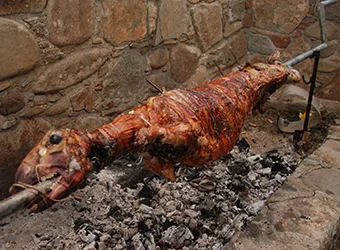
Undoubtedly one of the most typical images of the Greek Easter includes the family barbeque in the outdoors where the roasted lamb has a prominent place. Some scholars argue that the tradition of the roasted lamb (Greek: Οβελίας -ovelias-) may have its roots in the biblical era and the Jewish people who had to sacrifice a lamb or a goat to be blessed by God.
The special way of roasting the lamb on a spit probably comes from the Greek mountainous mainland where people were used to celebrating Easter close to their herds without access to ovens. On the islands, the Easter lamb is still cooked in the oven while in many areas the lamb can be replaced by a goat. The lambs or goat offal and intestines are used for the preparation of another Easter delicacy also roasted on a spit that is called kokoretsi. Those are two of the main courses included in the Easter table of a typical Greek Easter celebration.

A short calendar of the customs followed during the Holy Week and Pascha
Palm Sunday
Given that Palm-Sunday commemorates the start of the period of Christ’s Passion with his entry to Jerusalem, many faithful chose to immerse into the notion of the feast by visiting the church. After the morning divine service, people bring bay leaves distributed by the priest to their homes since it is considered a blessing. A family meal follows and traditionally, the main dish of the day includes fish.
Great Monday
It is the day that indicates the unofficial approaching of the major feast. Even those who have not observed fasting from the beginning of the Great Lent are encouraged to abstain from rich food. The cleaning is becoming a priority for each household since according to the tradition the mind, the body and the surrounding should be cleansed and purified in order to receive God’s message.
Great Tuesday
The cleaning procedures started from the previous day are followed up. Women in rural areas are used to paint the walls white using lime paint, while the flower pots are painted red as an implication of Christ’s blood on the Cross.
Great Wednesday
Many women reach the churches of their parishes holding a platter with flour. They fasten three lit candles in the flour and they keep the platter close to the priest's pulpit during the whole Divine Service. This flour is used for the tsoureki (sweet bread) baking the following day. Moreover, in some areas across the country, women mix water and flour and bring it to the church during the liturgy of the Great Wednesday. There the priest touches the dough with a cross and a bouquet of basil saying some blessings and prayers, after that the dough is used as the yeast for the bread baking during the whole year.
Great Thursday
This is the day when “tsoureki” the typical Easter sweet bread is baked in numerous Greek households. Those who are not willing to try their baking skills can buy it from bakeries even from supermarkets. Another activity related to Great Thursday is the egg dying tradition. Nowadays, many chose to use different colors in the dying procedure but the traditional red color that implicates Christ’s blood is still the dominant one. Finally, after the end of the evening-liturgy women and girls start the Epitaph decoration process.
Great Friday
Great Friday is the ultimate mourning day for Greek Orthodox Christianity. It is a public holiday and traditionally any potential household-work or any other activity is to be avoided. According to the tradition, the food of the day should not be cooked, while in many areas, people sustain only on bread. They also drink vinegar commemorating the vinegar wine that was offered the Christ on the Cross. The day ends with the Epitaph procession where the parishioners follow the litany along the streets of the community holding lit candles, while the church bells are ringing on a mourning tone.
Great Saturday
The anticipation feeling regarding Christ’s Resurrection dominates the environment during Great Saturday. This day includes the preparation of the first meal that is eaten after the Midnight Service of Resurrection. It is the so-called "mayiritsa" which is made with the inner organs and intestines of the lamb. At the Midnight Service, the priest announces the “Christos Anesti” (Christ has risen) at twelve o'clock and passes the flame of the Holy Fire to the crowd. The joyful bell-ringings spreads the message of resurrection, and fireworks are set off to the skies. All the faithful bring the Holy Fire to their homes and as they enter they make a cross sign to the entrance with the lit candle soot since it is considered as a blessing. Then, typically around 2 o'clock in the morning, a feastful dinner follows.
Pascha Sunday
This day can be characterized as the definition of festivity. And since the Greek culture associates the feast with great meals, someone can easily understand that the feast is organized around a table with an endless variety of dishes. From early morning a big fire is prepared in house yards and outdoors. The Easter lamb and kokoretsi are prepared for the spit and during the roasting process, traditional songs and music provide a feastful tone in the atmosphere. Parallel to that, plenty of wine and tsipouro (strong distilled spirit) accompany the celebration. Pascha is a typical day for the huge gathering of the greek extended-family joined by relatives and friends.
Pascha Monday
The last day of the official three-day public holiday is Pascha Monday. This is a day that the majority loves to take things slowly and relax as well as to consume the leftovers of the previous day. Some chose to attend the church service of the day, while others invest their time visiting friends and relatives or enjoying nature and its spring-vibes.
